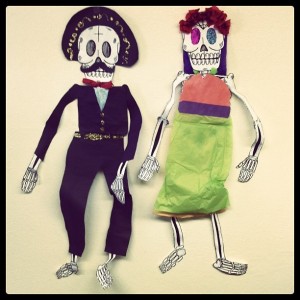 Tonight is our sixth and last workshop in our series on teaching about Día de los Muertos. We’ve had such a wonderful time with all of the teachers and community members who’ve participated this year. We’ve spent the last two days making pounds and pounds of sugar skulls and icing, so I’m sure tonight will be just as much as fun. We also just installed the ofrenda we created for the National Hispanic Cultural Center’s Día de los Muertos exhibit. To say our LAII k-12 outreach team has been busy lately just might be an understatement. We definitely plan to share some pictures of all of these fun projects soon! Continue reading
Tonight is our sixth and last workshop in our series on teaching about Día de los Muertos. We’ve had such a wonderful time with all of the teachers and community members who’ve participated this year. We’ve spent the last two days making pounds and pounds of sugar skulls and icing, so I’m sure tonight will be just as much as fun. We also just installed the ofrenda we created for the National Hispanic Cultural Center’s Día de los Muertos exhibit. To say our LAII k-12 outreach team has been busy lately just might be an understatement. We definitely plan to share some pictures of all of these fun projects soon! Continue reading
Tag Archives: Calaveras
WWW: Día de los Muertos at the National Hispanic Cultural Center
The phenomenon of Día de los Muertos can be traced through Mesoamerica, where death initiated a journey of the soul through the nine levels of Chicunamictlán (The Land of the Dead). Origins can also be traced through Europe, where the popes of four centuries grappled with paganism, eventually establishing All Saints Day and All Souls Days on November 1st and 2nd.
The National Hispanic Cultural Center (NHCC) has launched a Día de los Muertos website, exploring these fascinating origins, including the origins of specific elements like ofrendas and calaveras. The Día de los Muertos website also features lesson plans for ofrendas (all grade levels), calaveras (elementary), papel picado (all grade levels), and sugar skulls (all grade levels). Continue reading
En la Clase: What My Calavera Did at Night
 As many of you already know, literacy is one of my favorite ways to integrate cultural content, like Día de los Muertos, into a standards based curriculum. Not only does it reinforce the reading or writing skills that we work on throughout the year, it’s also a way to help ensure that we don’t fall into that trap of the “Tourist” approach to multicultural education. Too often when we teach this kind of cultural content, it appears to our students that we’re taking a break from our ‘real’ curriculum to do something fun. While these units can and should be fun, it shouldn’t appear that they’re not authentic and important parts of our curriculum. By combining this content with types of literacy activities done throughout the year, students don’t see these projects as less important than any others.
As many of you already know, literacy is one of my favorite ways to integrate cultural content, like Día de los Muertos, into a standards based curriculum. Not only does it reinforce the reading or writing skills that we work on throughout the year, it’s also a way to help ensure that we don’t fall into that trap of the “Tourist” approach to multicultural education. Too often when we teach this kind of cultural content, it appears to our students that we’re taking a break from our ‘real’ curriculum to do something fun. While these units can and should be fun, it shouldn’t appear that they’re not authentic and important parts of our curriculum. By combining this content with types of literacy activities done throughout the year, students don’t see these projects as less important than any others.
For today’s En la Clase, I’ve adapted a unit I typically used with my students when we returned to school in January. Many of you may be familiar with the book Snowmen at Night. In this story, a boy imagines what his snowman does at night while he’s sleeping. My students would make their own very large snowperson, then write a story about what their snowperson did at night. For my younger students, this was a project where I could introduce how to use a brainstorming web for a multi-paragraph paper, with each section of the web representing a different paragraph. For older students, it was practice for skills that they’d already learned. Hesitant writers were often excited and engaged by creating their snowperson before any of the writing began. Continue reading

